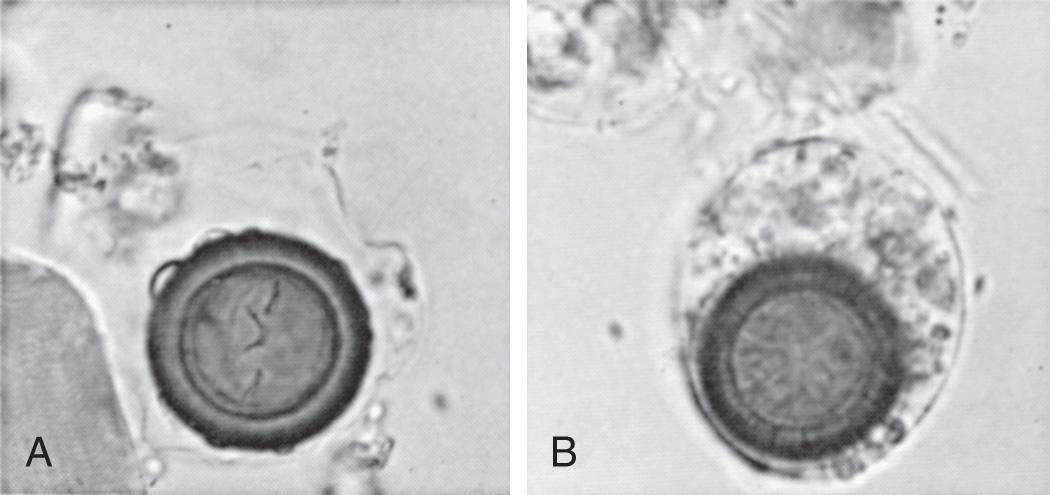Physical Address
304 North Cardinal St.
Dorchester Center, MA 02124
Tapeworms are adult forms of cestodes , multicellular helminth parasites, that live in human intestines and cause non–life-threatening illness. Invasive larval forms of cestodes are associated with cysts that lead to severe human disease such as neurocysticercosis ( Taenia solium ; see Chapter 329 ) and echinococcosis (mostly Echinococcus granulosa and E. multilocularis ; Chapter 330 ). The adult worms themselves are flat and multisegmented, varying in length from 8 mm to 10 meters (m). Table 328.1 summarizes the key features of tapeworms that affect children.
| PARASITE SPECIES | GEOGRAPHY | SOURCE | SYMPTOMS | TREATMENT |
|---|---|---|---|---|
| Taenia saginata | Asia, Africa, Latin America | Cysts in beef | Abdominal discomfort, motile proglottid migration, passing segments | Praziquantel or niclosamide, possibly nitazoxanide |
| Taenia solium | Asia, Africa, Latin America | Cysticerci in pork | Minimal, proglottids in stool | Praziquantel or niclosamide, possibly nitazoxanide |
| Taenia asiatica | Asia | Pigs | Minimal | Praziquantel or niclosamide, possibly nitazoxanide |
| Diphyllobothrium spp. | Worldwide, often northern areas | Plerocercoid cysts in freshwater fish | Usually minimal; with prolonged or heavy infection with D. latum , vitamin B 12 deficiency | Praziquantel or niclosamide |
| Hymenolepis | Worldwide, often northern areas | Infected humans, rodents | Mild abdominal discomfort | Praziquantel, niclosamide, or nitazoxanide |
| Dipylidium caninum | Worldwide | Domestic dogs and cats | Proglottids in stool, anal pruritus confused with pinworm | Praziquantel or niclosamide |
The beef tapeworm (Taenia saginata) , the pork tapeworm (T. solium), and the Asian tapeworm (Taenia asiatica) are long worms (4-10 m) named for their intermediate hosts ( T. saginata , T. solium ) or geographic distribution ( T. asiatica ; larval host is the pig). The adult worms are found only in the human intestine. As with the adult stage of all tapeworms, their body is a series of 100s or 1000s of flattened segments ( proglottids ) with an anterior attachment organ (scolex) that anchors the parasite to the bowel wall. New segments arise from the distal aspect of the scolex with progressively more mature segments attached distally. The gravid terminal segments contain 50,000-100,000 eggs, and the eggs or even detached intact proglottids pass out of the child through the anus (with or separate from defecation). These tapeworms differ most significantly in that the intermediate stage of the pork tapeworm ( cysticercus ) can also infect humans and cause significant morbidity (see Chapter 329 ), whereas the larval stage of T. saginata does not cause human disease. T. asiatica is similar to and often confused with the beef tapeworm.
The pork and beef tapeworms are distributed worldwide, with the highest risk for infection in Latin America, Africa, India, Southeast Asia, and China, where the relevant intermediate host is raised domestically. The prevalence in adults may not reflect the prevalence in young children, because cultural practices may dictate how well meat is cooked and how much is served to children.
When children ingest raw or undercooked meat containing larval cysts, gastric acid and bile facilitate release of immature scolices that attach to the lumen of the small intestine. The parasite grows, adding new segments at the base of the scolex. The terminal segments mature and after 2-3 mo produce eggs that are released in stool. The surface of proglottids serves as an absorptive organ to “steal” nutritional elements from the child's small bowel for use by the parasite. There is sometimes a transient eosinophilia before the parasite matures enough to release eggs.
Nonspecific abdominal symptoms have been reported with beef and pork tapeworm infections, but the most bothersome symptom is the psychologic distress caused by seeing proglottids in the stool or undergarments. The released segments of the worms are motile (especially those of T. saginata ) and sometimes lead to anal pruritus. The adult beef and pork tapeworms are only rarely associated with other symptoms.
Identification of the infecting tapeworm species facilitates understanding of risk for invasive disease. Carriers of adult pork tapeworms are at increased risk for transmitting eggs with the pathogenic intermediate stage (cysticercus) to themselves or others, whereas children infected with the beef tapeworm or T. asiatica are a risk only to livestock. Because proglottids are generally passed intact, visual examination for gravid proglottids in the stool is a sensitive test; these segments may be used to identify species. Eggs, by contrast, are often absent from stool and cannot distinguish between T. saginata and T. solium ( Fig. 328.1 ). If the parasite is completely expelled, the scolex of each species is diagnostic. The scolex of T. saginata has only a set of 4 anteriorly oriented suckers, whereas T. solium is armed with a double row of hooks in addition to suckers. The proglottids of T. saginata have >20 branches from a central uterine structure, and the proglottids of T. solium have ≤10 branches. Expelled proglottid segments are usually approximately 0.5 × 1-2 × 0.1 cm in size. Molecular methods can distinguish T. saginata from T. asiatica . Antigen detection tests are increasingly available.

Anal pruritus may mimic symptoms of pinworm (Enterobius vermicularis) infection. Diphyllobothrium latum and Ascaris lumbricoides (a long round worm) may be mistaken for T. saginata or T. solium in stools.
Become a Clinical Tree membership for Full access and enjoy Unlimited articles
If you are a member. Log in here